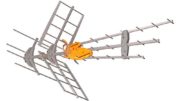Sadly, not quite. But it is good enough most of the time. And perhaps more importantly, the difference isn’t as big as it used to be.
A little prehistory
In the 20th century, North American broadcasting used a standard called NTSC. It was an analog standard for TV with 525 lines of vertical resolution. Of those, 480 were actually visible and the rest was called a “vertical blank”, created so the moving electrons could get back up to home position.
The rest of the world used a standard called either PAL or SECAM, and in both cases there were 625 lines of vertical resolution, with 576 of them visible. That’s quite a bit better detail.
Enter the digital age
Today, the US uses a standard called ATSC for television broadcasting. It does a great job of getting HD into broadcast channels that were originally designed for black-and-white standard definition, but it’s not “all that and a bag of chips.”
While the ATSC broadcasting standard is good for most things, avid antenna fans have noticed a few issues over the years. ATSC’s broadcast protocols are more prone to multipath interference than others, although they are better than older analog protocols. ATSC doesn’t work at all in moving vehicles while other standards do. That limits your ability to get free TV in an RV or boat.
Europe got better when we got better.
Most of the world today uses some variant of the DVB-T2 standard developed in Europe. At the time that digital TV was being proposed in this country in the years after 9/11 there was a big push to keep development in the US and that led to the ATSC standard. At the time it was better than the first-generation DVB-T standard in many ways, but certainly the DVB-T2 standard is the best in the world right now with support for broadcasts that travel further on less power and improved ability to get signal in a moving vehicle. No wonder that some European countries have over 75% of their homes with TV antennas.
Europe’s better-quality TV is not a new phenomenon, unfortunately. While the US struggled to modernize the aging NTSC standard to include color and stereo, most of the world moved to better quality just as quickly as we did. Initially, they used the DVB-T standard. This was pretty similar to the older standards, but added digital quality. So, while our TVs only interpreted 480 lines. DVB-T’s additional broadcast quality was quite noticeable, I can tell you as I saw side-by-side demonstrations back in the 20th century.
Will US TV ever catch up?
It’s possible that we’ll see some improvement in American TV if broadcasters embrace the upcoming ATSC 3.0 standard. It’s not just about 4K, it also will allow for interactive services, better mobile service, reduced multipath interference and theoretically better performance in fringe areas. But of course in order to get all that goodness you would need ATSC 3.0 broadcasts on an ATSC 3.0-compatible TV, which may or may not ever happen. It seems to me that without a massive effort from the government, it could take a decade or more before enough people buy new TVs with new tuners, and only at that point will we start seeing any sort of improved quality for most people.
Yes, TV in the United States is not as good as TV in other countries, but that’s really only true over-the-air. With up to 95% of Americans getting at least some TV from cable, satellite, or streaming, all quality issues are really irrelevant and here in the US we have the largest selection of channels on pay television of any country. So any other arguments really don’t matter.





